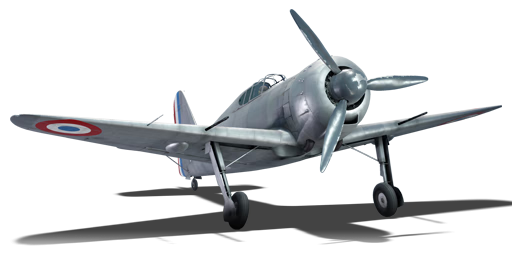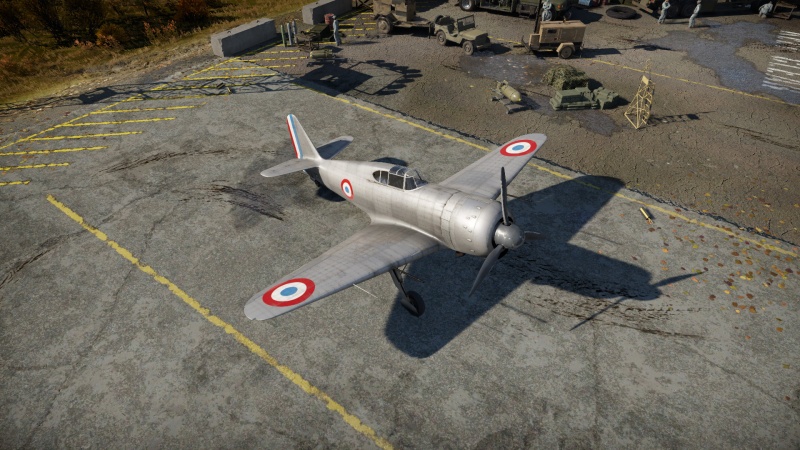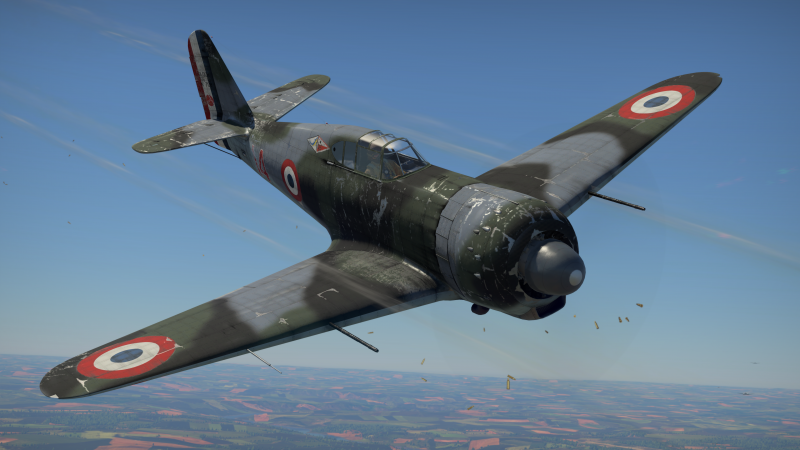M.B.157
Contents
Description
The Bloch M.B.150 series was a single seat, all-metal low-wing monoplane fighter featuring a fully enclosed cockpit and retractable landing gear, a very revolutionary design for the French Air Force at the time of its development in 1934. The development was hampered by operational problems during its development. In 1938, 25 preproduction aircraft were ordered. With further testing, improved versions like the 151 and 152 entered service at the outbreak of WWII, powered by 920 hp and 1,050 hp engines respectively. The M.B.157 was a prototype further development of the M.B.152, featuring an even more powerful 1,590 hp engine; however, only one prototype was built and it never saw service.
It was introduced in Update 1.73 "Vive la France". The M.B.157 is a solid fighter, well suited for boom and zoom tactics. It has an average climb rate but a powerful engine that allows good top speed in level flight, side climbing is recommended at the start of the match. It can quickly dive into unsuspected enemies from above and engage in dogfights if necessary, since it is a nimble fighter, it will be able to keep up and outperform other fighters in the hands of a good pilot. Since it has a small ammo pool, trigger discipline is required for the greatest efficiency.
General info
Flight performance
The M.B.157 is a solid aircraft powered with the Gnome-Rhône 14R engine which has a 1,600 maximum horsepower output. This aircraft has good manoeuvrability and acceleration allowing it to perform well in battle. While this aircraft has good acceleration, it is not a quick climber, and if you intend to fight from above, this aircraft will need to side-climb to the desired altitude. Due to the weight of the aircraft and its excellent energy retention, this fighter makes a great Boom & Zoom aircraft. With the beefed up wings of the MB.157 they are virtually unrippable as their shear speed is at 810 km/h; however, the combat flaps will begin to detach around 450 km/h and the landing gear at 340 km/h.
This aircraft has a decent roll and turn rate; however, extending combat flaps will aid in reducing turn time. Utilising the powerful rudder along with combat flaps allow for this aircraft to make tighter rolls and turns than with only using ailerons and elevators. Taking the M.B.157 into a steep climb during a rope-a-dope allows for the pilot to kick the rudder either direction at the peak of the climb (near stall speed) and perform a quick wing-over or hammerhead turn putting the pilot on the hunt for the stalled out chase aircraft. While this aircraft excels at Boom & Zoom tactics, pilots should familiarise themselves with this aircraft in a dive as control stiffening begins at around 450 km/h and almost full control lock-up begins after 650 km/h.
This aircraft cannot outfit external ordinances on underwing or belly pylons which would affect the weight and drag of this flight model.
For those pilots flying who desire to, the cockpit canopy can be left open during flight.
| Characteristics | Max Speed (km/h at 7,600 m) |
Max altitude (metres) |
Turn time (seconds) |
Rate of climb (metres/second) |
Take-off run (metres) | |||
|---|---|---|---|---|---|---|---|---|
| AB | RB | AB | RB | AB | RB | |||
| Stock | 683 | 664 | 9000 | 20.0 | 20.7 | 10.1 | 10.1 | 650 |
| Upgraded | 745 | 711 | 18.3 | 19.0 | 19.4 | 14.1 | ||
Details
| Features | ||||
|---|---|---|---|---|
| Combat flaps | Take-off flaps | Landing flaps | Air brakes | Arrestor gear |
| ✓ | ✓ | ✓ | X | X |
| Limits | ||||||
|---|---|---|---|---|---|---|
| Wings (km/h) | Gear (km/h) | Flaps (km/h) | Max Static G | |||
| Combat | Take-off | Landing | + | - | ||
| 810 | 340 | 448 | 419 | 270 | ~12 | ~9 |
| Optimal velocities (km/h) | |||
|---|---|---|---|
| Ailerons | Rudder | Elevators | Radiator |
| < 350 | < 350 | < 400 | > 350 |
Survivability and armour
- 10 mm Steel plate behind the engine
- 10 mm Steel plate behind the pilot's head
- 3 mm Steel plate box in the fuselage
- Self-sealing fuel tanks (1 under pilot)
The M.B.157 has some protective armour to protect the pilot. The largest piece of armour is the 10 mm steel plate located behind the engine and in front of the cockpit. Secondly, there is a 10 mm steel plate in the pilot's headrest to protect the pilot from bullets striking from behind. Thirdly there is a 3 mm steel box located behind the pilot and near the control surface linkage. Bullet-proof glass was not available on this aircraft making the pilot susceptible to being hit from head-on, top-down and side attacks. Critical components of the aircraft such as the engine, oil cooling system and the pilot's head are exposed during head-on attacks or while attacking bombers from behind. While the fuel tanks are protected from head-on attacks (situated below the pilot), unfortunately, they are vulnerable from almost every other angle.
Modifications and economy
Armaments
Offensive armament
The M.B.157 is armed with:
- 2 x 20 mm Hispano 404 cannons, wing-mounted (60 rpg = 120 total)
The Hispano 404 on the M.B.157 are excellent weapons, utilized on many different aircraft, but the big drawback on this plane is that each cannon is drum fed and has only 60 rounds per gun. With a firing rate of 700 rounds per minute, the quick depletion of ammunition is a reality. The pilot cannot rely on continuous fire due to the quickness of ammunition depletion and must practice well aimed, controlled bursts to conserve ammunition and make every shot count. Unless the pilot is highly skilled and comfortable with the Stealth belt ammunition, achieving more accurate shots require utilising the Default, Universal, or Ground Attack rounds which all contain tracer rounds in their mix.
Usage in battles
The M.B.157 has good energy retention and does well with Boom & Zoom tactics. While turn-fighting is not recommended as typically as it will leave you with low energy and a slow plane, if needed, you can utilize combat flaps and rudder to help make sharper turns when chasing down other aircraft or trying to dodge enemy aircraft fire. The .157 is an aircraft which can excel when it has an energy advantage over the enemy and to do so needs to side-climb on the map in order to get to a decent altitude. For this fighter, speed is key and having enough room to dive and zoom away will extend the pilot's ability to survive and line up another shot.
While the 60 rounds per gun are a pittance in any of the battle types, it is especially critical in Realistic or Simulator Battles. While Arcade players can get away with flying around while waiting out the reload time, Realistic or Simulator pilots will need to return to the base to reload before taking on any more enemy aircraft, which leaves you open to enemy counterattacks.
Specific enemies worth noting:
- P-47D-25/28: The legendary Thunderbolts are one of the very few aircraft that can match the M.B.157 at altitude. Being tuned for High-altitude operations, they gain the most power above 6,000m, easily reaching speeds that blitz past the poor Bloch. Also armed with a cacophony of 8 Browning .50 cals that can fit powerful incendiary tracers, it can set you ablaze with little to no trouble, so be sure to avoid its gunsights. Fortunately, the Jugs are very slow to turn and climb quite poorly, allowing you to outmanoeuvre them and out stall them with ease. If you spy a Thunderbolt reasonably close to your altitude, it's a smart choice to eliminate them before they can be a proper thorn in your side.
- Bf 109 F-4: Although the player must take care around most 109's at its battle rating, the F-4 is the one that can provide the most competition for the 157. They have far superior climb rates, energy retention and turn rates, along with quite solid armaments. However it is important to note that most F-4's will mount the additional gunpods that allow you to outturn it barely with the proper use of flaps and rudder, and is significantly slower than you. Speed and altitude are your best friends when fighting these aircraft, and take care not to engage them on their terms.
- Yak-3/9U/9K/9T: Although they cannot match you in terms of speed or acceleration, the mid-tier Yakovlev series are some of the best low altitude aircraft you can fight. They can turn on a dime, have great energy retention, and reasonably powerful armaments. While you cannot meet the Yak-3 in RB, it's one of the worst possible matchups for the 157 in AB, as it turns better than the other Yak's and is quite a bit faster than most of them as well. The Yak-9U is also worthy to note as it is the fastest 4.3 plane at sea level and turns reasonably well with energy. However, the glaring issue for all yaks is their poor performance above 4,000m - The 157's ideal altitude - along with their weak airframes. Boom-&-Zoom will be your flying style of choice when engaging these Russian beasts.
Manual Engine Control
| MEC elements | ||||||
|---|---|---|---|---|---|---|
| Mixer | Pitch | Radiator | Supercharger | Turbocharger | ||
| Oil | Water | Type | ||||
| Not controllable | Controllable Not auto controlled |
Controllable Not auto controlled |
Controllable Not auto controlled |
Separate | Controllable 2 gears |
Not controllable |
Pros and cons
Pros:
- One of the fastest aircraft at its tier
- Good energy retention
- Twin cannon setup is reasonably effective
- Acceptable climb rate (once upgraded)
- Virtually unrippable wings
- Reasonably high roll rate
Cons:
- Low ammo count: you need to make all your shots count
- Control surface lock occurs at high speed (during dives)
- Minimal armour on the sides of and behind the pilot
- Pilot easily knocked out when tailing bombers
History
Early development in 1934 by Société des Avions Marcel Bloch produced the Bloch M.B.150 single seat, all-metal low-wing monoplane fighter featuring a fully enclosed cockpit and retractable landing gear. While not initially chosen by the French Air Ministry for production, development continued on this aircraft. Following several setbacks and operational problems, a modified prototype was finally able to attain flight in 1937. Several additional modifications were necessary to refine this aircraft which included a more robust and strengthened wing and utilising the 14-cylinder two-row air-cooled radial Gnome-Rhône 14N-7 engine. During 1938 after running several trial runs, 25 preproduction aircraft were ordered.
Further testing refined the aircraft taking it to the improved version MB.151 and MB.152 which entered service at the outbreak of World War II. Unfortunately, most were determined to be unfit for combat service. Further testing led to the M.B.155 which had greater range and saw service until the fall of France. Not to be deterred, Vichy France completed several upgrades improving the flight model and installing the more powerful Gnome-Rhône 14R engine which lead to the designation of M.B.157. Unfortunately, this aircraft never entered service with only one prototype M.B.157 built.
Media
- Skins
- Videos
See also
Links to the articles on the War Thunder Wiki that you think will be useful for the reader, for example:
- reference to the series of the aircraft;
- links to approximate analogues of other nations and research trees.
External links
- [Devblog] The MB.157 fighter and a new pilot model for the French Air Force
- Official data sheet - more details about the performance
| Dassault Aviation | |
|---|---|
| WW2* | |
| Fighters | M.B.152C1 · M.B.157 |
| Bombers | M.B.162 · M.B.174A-3 · M.B.175T |
| Jet Aircraft | |
| M.D 450 | M.D.450B Barougan · M.D.450B Ouragan |
| Mystère | M.D.452 IIA · M.D.452 IIC · Mystere IVA |
| Super Mystère | Super Mystere B2 |
| Étendard | Etendard IVM |
| Super Étendard | Super Etendard |
| Alpha Jet | Alpha Jet E** |
| Mirage | |
| Mirage III | Mirage IIIC · Mirage IIIE · Milan |
| Mirage V | Mirage 5F |
| Mirage F1 | Mirage F1C · Mirage F1C-200 · Mirage F1CT |
| Mirage 2000 | Mirage 2000-5F · Mirage 2000C-S4 · Mirage 2000C-S5 · Mirage 2000D-R1 |
| Mirage 4000 | Mirage 4000 |
| Export | |
| M.D 450 | M.D.450B Ouragan |
| Mystere | Mystere IVA |
| Super Mystère | Sambad · Sa'ar*** |
| Mirage | Shahak |
| *The company was named "Société des Avions Marcel Bloch" before being renamed in 1947 | |
| **Jointly manufactured with Dornier Flugzeugwerke | |
| ***Israeli Super Mystère refitted with new avionics and an American engine | |
| France fighters | |
|---|---|
| Dewoitine | D.371 · D.371 H.S.9 · D.373 · D.500 · D.501 · Pallier's D.510 · D.520 |
| Morane-Saulnier | M.S.405C1 · M.S.406C1 · M.S.410 |
| Arsenal | V.G.33C-1 |
| Bloch | M.B.152C1 · M.B.157 |
| Caudron | C.R.714 |
| Sud-Ouest | S.O.8000 Narval |
| American | H-75A-1 · H-75A-4 · ▄P-39Q-25 · ▄P-40F-5 Lafayette · ▄P-47D-22-RE · ▄P-63C-5 · F-6C-10-NA |
| ▄F6F-5 · ▄F6F-5N · F4U-7 · ▄F8F-1B | |
| Other countries | ▄Seafire LF Mk.III · ▄Yak-3 · Challe's ▄Yak-9T · NC.900 |






